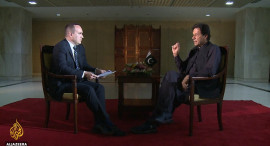
KARACHI: In line with the market expectations, the State Bank of Pakistan (SBP) has left the key interest rate unchanged at an eight-year high of 13.25% for the next two months.
The SBP Monetary Policy Committee (MPC) announced status quo in the rate to control inflation, which remained high in the first two months (July-August) of the current fiscal year 2020 due to late impact from the previous depreciation in rupee against US dollar, increase in power and gas tariffs and surge in food prices.
The central bank has kept its projection for inflation unchanged at 11-12% for the full fiscal year 2020.
"Inflation could begin to fall earlier than expected if (international oil prices decline, aggregate demand slows faster than expected, or the (rupee-dollar) exchange rate appreciates," the central bank hopped in a press statement on Monday.
Inflation, however, could rise above the baseline projections in case of fiscal slippage; low revenue collection or other adverse developments, it said.
"The decision (status quo in interest rate) reflected the MPC's view that inflation outcomes have been largely as expected and inflation projections for FY20 have remained unchanged since the last MPC meeting on July 16, 2019," it added.
The inflation was recorded at 10.5% against the expectation for over 11% in August 2019. The reading came lower than expected following a change in the base year to 2015-16 from 2007-08.
Chances for an uptick in inflation reading remain bleak following settlement of related issues in the domestic economy. However, likely increase in international oil prices remains a strong threat to the economy, as Pakistan meets its 70-80% energy needs through imports.
POL prices in Pakistan likely to go up after attacks on Saudi oil plants
Earlier, the central bank had hiked the key interest rate by a massive 7.5% in the past two-and-half-year to 13.25% in July.
Majority of the analysts were of the opinion that the interest rate has peaked out and a rate cut was imminent to let economic activities revive.
The economic growth slowed down to a nine-year low at 3.3% in the previous fiscal year, ended June 30, 2019. The high-interest rate regime caused the slowdown, but fought hard against inflation and helped in narrowing down current account deficit, which had battered foreign currency reserves.
The central bank also let the rupee aggressively depreciate to fix the faltering economy. The currency depreciated 52% since December 2017 to Rs160.05 to the US dollar on June 30, 2019.
"On a cumulative basis, borrowing by the private sector contracted 1.3% in July-August FY20, showing the results of previous monetary tightening," SBP said.
The MPC noted that inflation developments were broadly similar between the new and the old base CPI: inflation had gradually risen over the previous months and remained high in both year-on-year and month-on-month terms. Core inflation had also risen in recent months.
"These developments were in line with the SBP's earlier projections," the central bank said.
Rupee-dollar volatility ends
The uncertainty and volatility in the rupee-dollar exchange rate came to an end following the central bank largely ending its control over the rate's fixed. The banks decide the rate keeping in view the situation of demand and supply of US dollars in the inter-bank market.
"Reflecting these improved sentiments and continued adjustment in the current account, the rupee had strengthened modestly against the US dollar since the last MPC, unlike its previous trend," it said.
Secondly, the US Fed reduced its policy rate by 25 basis points recently, followed by policy rate cuts by other major central banks around the world.
"This would help in lowering pressures on emerging markets' currencies and potentially increase financial inflows," it said.
GDP to grow 3.5% in FY20
The central bank also kept its projection for growth in the gross domestic product (GDP) unchanged at 3.5%, which is almost one percentage point higher than International Monetary Fund's (IMF) forecast for the current fiscal year 2020.
"Economic activity would gradually turn around as business sentiment improves," MPC noted.
Analysts expect SBP to keep the rate unchanged
"The SBP-IBA Consumer and Business Confidence Surveys conducted during August-September 2019 show a modest improvement in the outlook for the economy," SBP statement said.
The outlook for agriculture and the services sectors was largely unchanged from the time of the previous MPC meeting. The agriculture sector growth is expected to improve considerably in FY20 over the last fiscal year, while growth in services is expected to moderate gradually.
SBP added the recent economic activity indicators show a gradual economic slowdown. The slowdown is more pronounced in domestic industries such as automobiles and steel. This trend is also reflected in the Large-Scale Manufacturing (LSM) index which contracted by 3.6 percent in FY19, somewhat more than earlier expectations. On the other hand, the MPC noted that the LSM index does not fully capture activity in some key industries such as high value-added textile products.
"Export volumes have been growing briskly even though the growth in export dollar proceeds has been less pronounced due to declining international unit prices," it said.
The central bank noted that the country's foreign currency reserves have improved with a significant drop in current account deficit in FY19 and at the outset of FY20, receipt of IMF disbursement and supply of petroleum oil on deferred payment by Saudi Arabia.





















































COMMENTS
Comments are moderated and generally will be posted if they are on-topic and not abusive.
For more information, please see our Comments FAQ